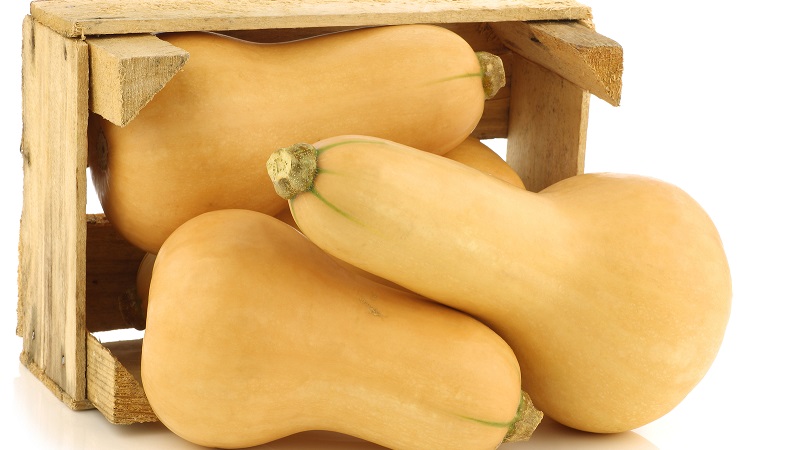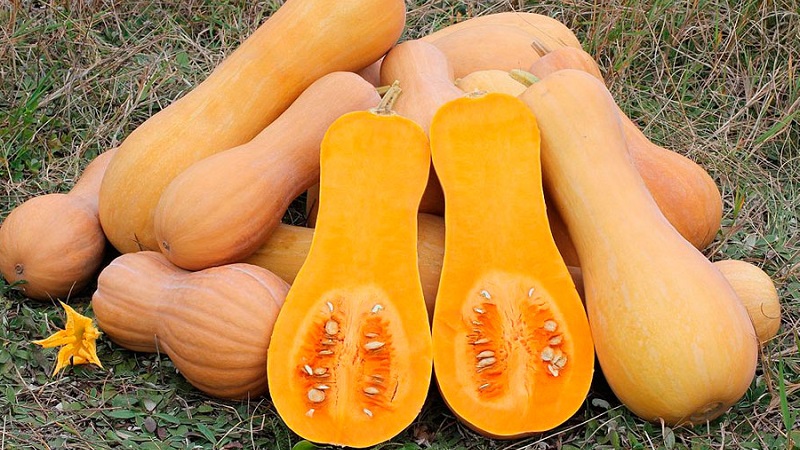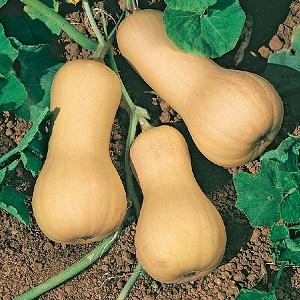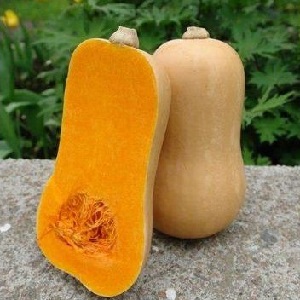The favorite of gardeners and culinary specialists is the pumpkin "Butternut": we grow it without hassle and use it in delicious recipes
The unusual taste, nutmeg aroma and sweet flesh of this exotic vegetable bred in the USA will leave no one indifferent. Today we will talk about a hybrid of butternut pumpkin and wild bottle pumpkins - Butternut pumpkin. In the article you will find everything about this culture - features, planting rules, care and application.
The content of the article
Description of the variety and distinctive features of Butternut pumpkin
The pumpkin got its name due to its unusual taste for this vegetable culture.... It resembles nut butter (from English butternut translates as "butter nut"). Therefore, the vegetable is also called "nut pumpkin".
Early maturing variety Butternat. After planting by seed, the crop is harvested after 90 days, and seedlings - even faster. In the middle lane, experienced vegetable growers recommend growing Butternut by seedlings, and in the south, already at the beginning of June, seeds are thrown directly into the ground.

In the photo, pumpkin varieties Butternut.
Fruit characteristics and yield
Pear-shaped Butternut fruit, which also resembles a guitar... The color of the pumpkin, depending on the degree of its ripeness, varies from yellowish orange to pink-orange. The rind is thin but firm. The average weight of one pumpkin is about 1.5 kg, the maximum is 3-4 kg.
The pulp is light orange (pale), sweet with nutmeg and nutty flavor and aroma, loose and juicy in texture... All seeds are concentrated in the lower (wide) part of the fruit.
Important. Butternut pumpkin has a high yield. In favorable climatic conditions and with proper care, up to 15 kg of fruits are harvested from one medium-sized bush. On average, one plant produces from 5 to 15 pumpkins.
How to grow
Pumpkin Butternut is a heat-loving plant... Recall that it is possible to plant it in the ground with seeds only in the southern regions, where there are no frosts in the middle of autumn. In the middle lane and northern regions, the seedling method is used.
Seed preparation
First of all, pumpkin seeds are heated... This is done for 1-2 months near a heating device or stove. Warming up increases the chances of getting more female flowers, which means a good harvest. Then the planting material is prepared.
Preparation consists of a number of activities:
- Seed selection... Empty seeds are discarded at this stage. To determine if the seeds are empty or not, they are placed in a salt solution. Those that do not drown are empty and are not suitable for landing.
- Hardening... The seed, wrapped in a damp cloth, is kept in the refrigerator for three days. This helps the seedlings to quickly adapt to weather changes.
- Disinfection... Before planting, the seeds are soaked for 10 hours in a weak solution of potassium permanganate or water with aloe juice.
Planting with seeds
To plant seeds early, warm beds of compost or manure are prepared in the fall.... Wells are made immediately and filled with fertile soil. When the beds are ready, they are covered with transparent plastic. This allows biofuels to start heating the soil as early as March.
In mid-May, pre-germinated seeds can already be planted in holes to a depth of 2-3 cm... In this case, the film is not removed, but holes are made in it above the hole.
Important! If frosts are still expected, the beds must be covered with foil.
Seedling
Seeds are planted on seedlings in early May.... Most gardeners use special pots with nutritious soil. Seedlings require regular moisture, but excessive moisture should be avoided. The pots of seeds are covered with a film, creating a greenhouse effect, but periodically they must arrange ventilation.
Landing
It is better to plant seedlings in loamy soil in the sunny part of the garden... The recommended distance between the beds is 0.6-0.7 m. The optimal period for planting seedlings in the ground is early June, when frosts are no longer expected.

Care
Butternut is not as capricious as it is described.... It doesn't take much time and effort. However, there are nuances in caring for this vegetable.
Watering and mulching
Watering plays a special role in the cultivation of Butternut pumpkin... Experienced vegetable growers combine it with weeding the beds and loosening the soil. The soil is regularly loosened to avoid the formation of a crust that interferes with the penetration of air and moisture to the roots of the plant. During the second loosening, about a month after the emergence of mass shoots, it is important to remove all weeds and carefully spread the growing lashes of the plant.
After female flowers have appeared on the plant and ovaries have formed, it is watered at least three times a month.... In August, watering is reduced, which allows already formed fruits to accumulate sugar content and form the most durable crust.
Attention! Watering must be stopped after the fruits reach the size of a small apple, otherwise the pumpkin will be watery.
The soil under the bushes is additionally mulched with straw, hay or construction sand... This is done to retain moisture and prevent weed growth. It is good to use vermiculite or coconut briquettes to regulate soil moisture.
Top dressing
During flowering and the formation of a large number of ovaries, it is important to feed the plant... It is correct to do this simultaneously with irrigation measures. Apply mineral fertilizers to feed the pumpkin carefully. And they must be alternated with organic fertilizers (chicken droppings or cow dung diluted in water).
Read about other pumpkin varieties:
One of the most popular varieties of pumpkin "Vitaminnaya"

A good result is obtained by enriching the soil with wood ash... Herbal infusions, including nettle, will also be beneficial.
Important! Pumpkin does not like acidified soil. Therefore, after applying organic fertilizers that increase acidity, wood ash is added. It is introduced during watering (2 glasses of ash are taken on a bucket of water) or sprinkled on top.
Features of cultivation and possible difficulties
Insofar as Butternut pumpkin is a heat-loving southern plant, it is important to observe the temperature regime... For active growth and development, the air temperature during the day should be at least + 25 ° C, and at night - at least + 15 ° C.
There are a number of other features in growing Butternut pumpkin:
- This variety is also picky about lighting. It should be planted in the sunniest place in an area protected from northern winds.
- The climbing variety requires more area when grown horizontally. Therefore, sometimes this variety is planted near the southern wall of the house, having arranged a trellis there.
- To fill the ovaries, Butternut requires regular watering. With a lack of water, the vegetable grows poorly and bears fruit.
Growing tips from experienced gardeners
 Growing a plant and its subsequent care has its own characteristics. Experienced vegetable growers already know them, so to get a good harvest of pumpkin Butternut is recommended:
Growing a plant and its subsequent care has its own characteristics. Experienced vegetable growers already know them, so to get a good harvest of pumpkin Butternut is recommended:
- Plant after legumes or cruciferous plants.
- For the entire growing season, carry out two dressings. The first is in the two-leaf phase, after weeding. The second is in the four-leaf phase.
- Timely remove wilted flowers that provoke rotting of cuttings, stems and fruits.
- Leave only two lashes on each plant.
- Pick off the fruits, leaving only 2-3 pumpkins on one lash.
Diseases and pests
An important point in caring for any plant is protection from diseases and pests.... To prevent infection, the plant should be watered on time, weeds removed and the soil should be loosened in time. Before planting, it is important to fertilize the soil with natural dressings.
Important! The most dangerous pests for this variety are spider mites and aphids. The only remedy for them is timely watering and cleaning of diseased leaves. The plant cannot be treated with chemicals.
Harvesting and application of the crop
Pumpkin reaches full maturity in 90 days from the moment of germination... The crop is usually harvested in September on dry, warm days, without waiting for frost.
Cut the fruits of the pumpkin Butternut should be with a small stalk (about 5 cm)... Then they will ripen and last longer. Butternut is a winter variety: if stored properly, it will last until spring without losing its taste.
Important! When harvesting, the main thing is to be in time before the first frost. When grown in unfavorable climatic conditions, the fruits are removed immature. However, it is also not worth picking pumpkins too early - the crust should harden. Otherwise, the vegetable will rot.
Application
Butternut pumpkin is the most popular vegetable in America.... They grow it for different purposes. Large pumpkins are used as feed for livestock and poultry. Medium-sized fruits - for making juices, purees and canned products. This variety is consumed both thermally and raw.
All over the world, butternut pumpkin is used to prepare cereals, mashed soups, casseroles and pancakes. The vegetable is used in meat and pasta dishes... Due to the small size of the fruit, it is baked whole or stuffed with vegetables / meat, creating exquisite culinary masterpieces. Juicy pulp is also used fresh - as part of cuts and vegetable salads. Dessert dishes are also prepared from Butternut: puddings, pastries, cakes, candied fruits.
Recipe for baking whole pumpkin in the oven:
- For the preparation of this dish, only small fruits weighing no more than 1 kg are suitable.
- The vegetable is cut lengthwise into two halves, the seeds are removed and placed in a baking dish or on a baking sheet, skin side down.
- Sprinkle cinnamon on top of the pumpkin and place in the oven at 180 degrees for about half an hour.
- The finished dish can be greased with a piece of butter.
How to store
Until the onset of cold weather, the pumpkin is stored on a closed balcony or in another dry room... When the air temperature starts to drop below + 5ºC at night, the fruits are transferred to a warmer place. You can store the vegetable in the apartment, but the optimal storage temperature is from +4 to + 8ºC.
It will be interesting:
Advantages and disadvantages of the variety
 The "nut pumpkin" has many advantages over other varietiespopular in our country. Its fruits contain a huge amount of vitamins and minerals necessary for the body. Therefore, it is suitable for baby and diet food.
The "nut pumpkin" has many advantages over other varietiespopular in our country. Its fruits contain a huge amount of vitamins and minerals necessary for the body. Therefore, it is suitable for baby and diet food.
Among the virtues of Butternut:
- high productivity;
- early maturity (already about 80 days after planting, the pumpkin can be eaten);
- easily pollinated - no need for artificial pollination;
- versatility in preparation, the ability to use raw fruits;
- unique taste and aroma;
- a small mass of fruits (up to 4 kg, and on average - 1.5 kg), which allows you to consume the whole vegetable at once;
- thin peel, which facilitates the process of cleaning the vegetable;
- a small amount of seeds, concentrated only in the lower part of the fruit;
- long storage period without loss of vitamins.
Butternut has practically no drawbacks... All a plant needs is proper watering and proper care.
Farmers reviews
There are more positive reviews about Butternut than negative ones.... Farmers appreciated both the taste of the pumpkin and its yield. In addition, gardeners highlight a number of other advantages of this culture. Here are a few reviews of vegetable growers from different parts of our country:
 Svetlana, Stavropol Territory: “This year my husband and I first tried to grow Butternut pumpkin on our site. We were quite pleased with the result. Of course, on the one hand, this variety is very capricious, but on the other hand, it keeps well and grows small. This allows us to prepare a dish from all vegetables at once - good advantages for us ".
Svetlana, Stavropol Territory: “This year my husband and I first tried to grow Butternut pumpkin on our site. We were quite pleased with the result. Of course, on the one hand, this variety is very capricious, but on the other hand, it keeps well and grows small. This allows us to prepare a dish from all vegetables at once - good advantages for us ".
Sergey, Kemerovo region: “Butternut has grown quite a decent harvest in the country. I liked the unusual taste. I eat it both raw and cooked and plan to plant a little more of it next year, because it keeps well. ".
Nikolay, Novosibirsk region: “I spend every summer at my dacha, so growing such a demanding variety has not become a problem for me. I recommend it for planting rather to experienced gardeners, since caring for a plant requires some experience and knowledge ".
Conclusion
Butternut is one of the most popular pumpkin varieties today. You will appreciate its delicate taste, nutmeg aroma and convenient small fruit size. With proper care of this crop, even a beginner will achieve a good harvest. The characterization of Butternut as a capricious plant is greatly exaggerated. Growing a fragrant "nut gourd" is not as difficult as it might seem at first glance.